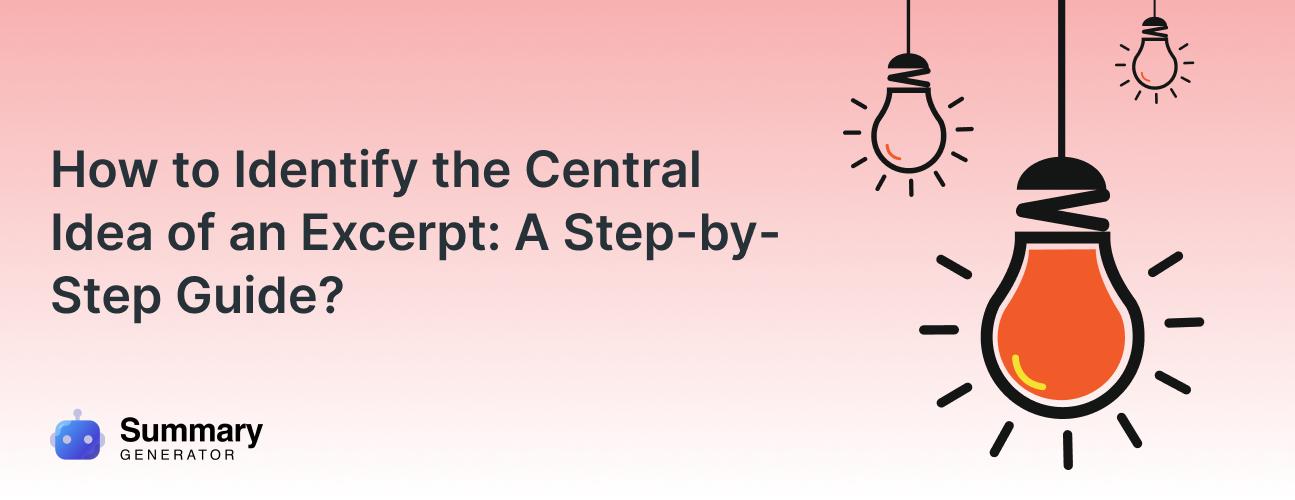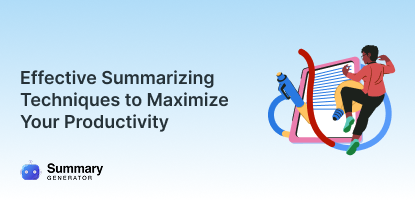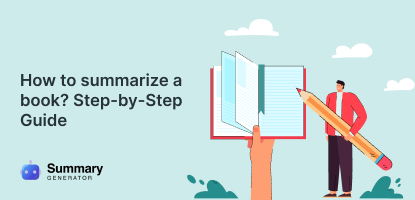Every content has a core idea or message, and the entire piece revolves around it. Whether it’s a news article, blog, research paper, or novel, the central idea holds different parts of the text together.
However, sometimes, we fail to spot or pinpoint it accurately. Do you want to learn to extract the main message from any excerpt? This guide can help. In this guide, we will share some basic steps to find the central message of any type of content. But before that, let’s get to the basics!
What is the Central Idea of an Excerpt?
The central idea is the core message or argument the author wants the reader to understand. In other words, it’s the spine of the text. Everything else mentioned in the content, including examples, statistics, quotes, and arguments, is meant to support it.
For instance, in an excerpt from a TED talk, the central idea might be a bold opinion. In a product review, it might be a verdict. In a history textbook, it could be a cause-and-effect relationship. Regardless of format, the central idea is always what the author is trying to say, not just what they say.
Key Characteristics
The key idea of any text holds three main characteristics, including;
- Conciseness: It’s very short and to the point. It can be summarized in just one or two sentences.
- Universal: The central idea is not built for a specific section or chapter. It applies to the entire excerpt.
- Supportable: The central idea is generally supportable. All the arguments or evidence presented in the study or debate are meant to support the central idea.
Why It Matters?
The central idea isn’t just an academic concept. It matters in almost every field. Take a look at why professionals across fields rely on it:
In business
Marketers decode customer insights from interviews. Product managers read user feedback and boil it down to a pain point. If they miss the central idea, they miss the product-market fit.
In journalism
Editors determine which news angle matters most. Without identifying the central idea, articles lose direction.
In law
Lawyers analyze precedents and briefs. They’re trained to extract the key arguments quickly. That’s the central idea in action.
In content strategy
Writers use the central idea to build headlines, create value-driven content, and avoid rambling.
When you can isolate the central idea, you make better calls and become a sharper reader, more thoughtful communicator, and faster thinker.
Step-by-Step Process to Identify the Central Idea
Identifying the core message of a piece of content isn’t very difficult at all. Anyone can easily discover it by just reading or watching the content. Still, if you struggle to find it, follow these steps!
Step 1: Read the Excerpt Thoroughly
If you want to find the idea of a piece of content, thoroughly read the entire content. Read every single word and sentence. Don’t just skim the text. The idea often hides in tone shifts, word choice, or even in patterns. Therefore, skimming it might not be helpful at all.
Moreover, if the text is confusing or you fail to find the idea, take another look. And this time, be more attentive. In your second pass, look for structural clues. Is the author setting up a contrast? Making a claim? Offering a solution? This will surely help you get what you are looking for.
Step 2: Determine the Author’s Main Point
Now we turn to the purpose. What is the author trying to say about the topic? That’s the central idea.
It can be a claim like “Remote work improves productivity,” a warning like “Neglecting cybersecurity invites data breaches,” or even a discovery like “AI can now outperform radiologists in early detection.” However, in each case, analyze what the author wants to communicate.
To find the main idea, look at:
- The first and last sentences
- Sentence transitions (however, therefore, for example)
- Emotional tone (hopeful, critical, persuasive)
The central idea is often direct if the excerpt is an opinion piece. In data-heavy writing, it’s usually inferred. You should examine the text thoroughly to find it.
Step 3: Look for Repeated Concepts
Here is a reliable method to identify the central idea of any study. Check out what words, phrases, or ideas appear more than once. Repetition isn’t always filler. In most cases, it’s an intentional emphasis.
For instance, in a corporate memo about budget cuts, if “efficiency,” “streamlining,” and “cost-saving” appear in multiple paragraphs, that’s no accident. The central idea probably relates to operational efficiency, not just financial trimming. Tracking repetition helps you spot patterns. Those patterns point to the purpose of the study.
Step 4: Summarize the Text
When it comes to finding the main idea, summarizing the text can be your best partner. If you don’t want to read the entire content, simply summarize it to extract the key ideas with an AI summary generator. It will help your readers get the main idea quickly without ruining the context or missing key points.
Conclusion
Finding the central idea isn’t a guess. It’s a process. The process requires attention, curiosity, and clarity. For that purpose, you start by reading slowly, finding the thesis statement, seeing repeated patterns or words, and then summarizing the text. These steps can help you know exactly what the author wants to communicate.
If you implement these strategies, whether you are decoding a memo, writing a blog, or scanning a research report, you’ll never ask, “Wait, what was the point?” again. The central idea will be clear. And so will your next move.



